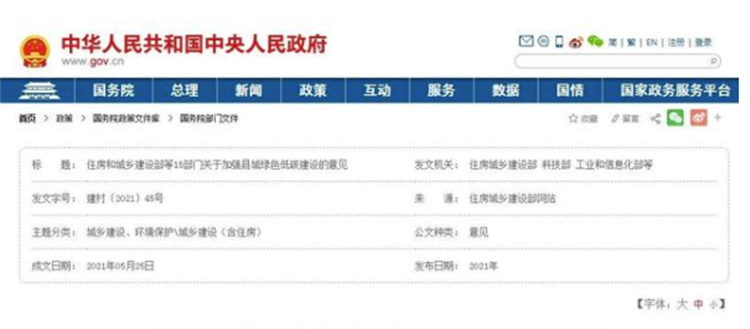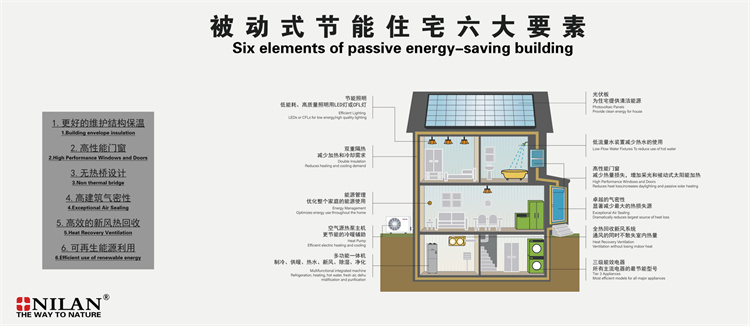[Solution]

Recently, the Ministry of Housing and Urban-Rural Development, together with 15 departments, issued an opinion, proposing to increase the proportion of rooftop photovoltaics in public buildings, implement photovoltaic building integration, and promote distributed photovoltaics, smart photovoltaics and other clean energy applications. Distributed photovoltaic projects and photovoltaic building integration usher in new opportunities for development!

China's Ministry of Housing and Urban-Rural Development issued a message on June 8, and 15 departments including the Ministry of Housing and Urban-Rural Development issued opinions on strengthening the green and low-carbon construction of county towns. The opinions put forward to accelerate the certification of green building materials and promote the application of green building materials. By increasing the proportion of rooftop photovoltaics in new factories and public buildings and implementing photovoltaic building-integrated development, the proportion of traditional fossil energy in building energy consumption will be reduced. Build a green and low-carbon energy system in the county, promote the application of clean energy such as distributed wind power, distributed photovoltaics, and smart photovoltaics, improve the level of clean energy consumption in production and life, promote comprehensive smart energy services, and strengthen distribution networks, energy storage, and electric vehicle charging. Pile and other energy infrastructure construction.

The county seat is the center of the economic and social development of the county and the key node of the integrated development of urban and rural areas, and an important carrier to promote the green development of urban and rural areas. In order to thoroughly implement the spirit of the Fifth Plenary Session of the 19th Central Committee of the Communist Party of China and the deployment requirements of the "14th Five-Year Plan", and promote the green and low-carbon construction of the county, the following opinions are hereby offered.
I. Fully understand the significance of promoting green and low-carbon construction in the county
In situ urbanization with county seat as the carrier is an important feature of my country's urbanization. There is an increasing demand for county-level agricultural transfer populations and returning migrant workers to settle down in county towns. Improving the quality of county town construction and enhancing the comprehensive service capability for the county area plays an important role in promoting new-type urbanization and rural revitalization with people as the core. Since the reform and opening up, my country's county construction has made remarkable achievements, and the appearance of the county has undergone tremendous changes. However, there are still many problems and shortcomings in the scale and layout of the county, density intensity, infrastructure and public service capabilities, and the quality of the living environment. There are urgent needs. Change the way of copying the city's development and construction, and promote the green and low-carbon development of county construction. Strengthening the green and low-carbon construction of county towns is an inevitable requirement for implementing new development concepts and promoting high-quality development of county towns. , an important measure to meet the growing needs of the people for a better life. All localities must base themselves on the new development stage, implement new development concepts, promote the construction of a new development pattern, adhere to the people-centered development philosophy, coordinate the economic needs, living needs, ecological needs, and safety needs of the county’s construction and development, and promote the county’s quality and efficiency. , to improve the carrying capacity and public service level of the county, enhance the comprehensive service capacity of the county, lead the high-quality development of the county with a green and low-carbon concept, promote the formation of green production methods and lifestyles, and promote the realization of carbon peaking and carbon neutrality goals.
II. Strictly implement the relevant requirements for green and low-carbon construction in the county
(1) Strictly abide by the bottom line of county construction safety. The county construction should adhere to the system concept, coordinate development and safety, and clarify the safety bottom line requirements for county construction. New buildings in the county seat should be constructed in safe and suitable locations, avoiding areas prone to natural disasters such as seismically active faults, floods, landslides, and debris flows, as well as mining goafs, etc., and conduct disaster prevention safety demonstrations. Strengthen the construction of flood control, drainage and disaster reduction projects, unblock flood passages, reserve enough space for flood storage and detention, improve the system of non-engineering measures, and improve the ability to prevent and control flood risks.
(2) Control the density and intensity of county construction. County construction should be dense, well-proportioned, and rationally laid out. It is necessary to prevent blindly high-density and high-intensity development, and to prevent the spread of pie in a disorderly manner. The population density of the built-up area of the county should be controlled at 60,000 to 10,000 people per square kilometer, and the ratio of the total construction area to the construction land area of the built-up area of the county should be controlled at 0.6 to 0.8.
(3) Limit the height of civil buildings in county towns. The height of civil buildings in the county should match the fire rescue capability. The newly built residential buildings in the county are mainly 6-storey, and the floor area of 6-storey and below residential buildings should not be less than 70%. Encourage new multi-storey residential buildings to install elevators. The maximum of new residential buildings in the county seat shall not exceed 18 floors. If it is really necessary to build a residential building with more than 18 floors, it should be strictly and fully demonstrated, and the construction of fire emergency emergency and municipal supporting facilities should be in place. Strengthen the fire safety management of public buildings above 50 meters. The fire resistance rating, fire separation distance, and plane design of buildings must meet the mandatory requirements of fire protection technical standards.
(4) The county construction should be in harmony with the natural environment. County construction should be integrated into nature, conform to the original topography, do not dig mountains, fill rivers and lakes, do not damage the original landscape environment, and maintain the landscape and natural features. Protect and restore the buffer zone of rivers and lakes and the natural curvature of rivers, and do not develop or construct houses in the name of wind and rain covered bridges. The greening and beautification of the county town mainly uses native plants to realize the organic integration of the county town features and the surrounding natural ecosystems of mountains, rivers, forests, fields, lakes, grass and sand, and the landscape of agriculture, forestry and animal husbandry. Make full use of natural conditions to promote the construction of ecological greenways and green recreational spaces in the county.
(5) Vigorously develop green buildings and building energy conservation. New buildings in the county should implement the requirements for basic green buildings, and encourage the development of star green buildings. Accelerate the implementation of green buildings and building energy-saving and water-saving standards, strengthen design, construction and operation management, and continuously increase the proportion of green buildings in new buildings. Promote energy-saving and water-saving renovation and functional improvement of old residential areas. Water-saving appliances must be installed in new public buildings. Accelerate the promotion of green building materials product certification, and promote the application of green building materials. Develop new construction methods such as prefabricated steel structures. Fully implement green construction. Improve the energy use efficiency of the county, vigorously develop renewable energy that adapts to local resource endowments and needs, develop and utilize geothermal energy, biomass energy, air source and water source heat pumps according to local conditions, and promote clean district heating and clean heating in northern counties. The proportion of rooftop photovoltaics in factories and public buildings and the implementation of photovoltaic building-integrated development, etc., reduce the proportion of traditional fossil energy in building energy consumption.
(6) Build green and energy-saving infrastructure. The infrastructure construction of the county should be suitable for the local characteristics, mainly in the mode of miniaturization, decentralization and ecologicalization, so as to reduce the cost of construction and operation and maintenance. Advocate a combination of large-scale decentralization and small-area centralized infrastructure layout, coordinate the layout of water, electricity, thermal communication and other facilities in the county, arrange distributed energy, domestic waste and sewage treatment facilities according to local conditions, reduce the construction and operation costs of transmission and distribution pipelines, and cooperate with local conditions. The surrounding natural ecological environment is organically integrated. Strengthen the classification of domestic waste and the recycling of waste materials. Build a green and low-carbon energy system in the county, promote the application of clean energy such as distributed wind power, distributed photovoltaics, and smart photovoltaics, improve the level of clean energy consumption in production and life, promote comprehensive smart energy services, and strengthen distribution networks, energy storage, and electric vehicle charging. Pile and other energy infrastructure construction.
(7) Strengthen the protection and inheritance of the county's history and culture. Protect and inherit the history, culture and style of the county, and preserve the overall pattern of traditional blocks and the original network of streets and alleys. Do not demolish historical buildings, do not damage the historical environment, and protect ancient and famous trees. Accelerate the delineation of historical and cultural blocks and the determination of historical buildings and historical water systems, promptly identify and announce old city areas, buildings and water conservancy projects with conservation value, implement listing surveying, mapping and filing, clarify protection management requirements, and ensure effective protection and rational utilization. Promptly approve and announce the cultural relics protection units, do a good job in the "four possessions" of cultural relics protection units and register immovable cultural relics for listing protection, increase the protection and repair of cultural relics, and promote the opening and utilization of cultural relics. Implement the fire safety responsibilities of cultural relics, and strengthen the provision and maintenance of fire water supply, fire fighting facilities and equipment. In the construction and development of county towns, attention should be paid to avoiding large-scale ancient tombs.
(8) Build a green and low-carbon transportation system. Build a pedestrian-friendly county transportation system and build a continuous and smooth pedestrian network. Open up broken roads on pedestrian paths, connect interrupted nodes, optimize street facilities, clean up illegal road occupations, and improve road accessibility. Improve safety measures, strengthen management and maintenance, and ensure pedestrian safety. Encourage the county to build continuous and safe bicycle lanes. Prioritize the development of public transportation and guide green and low-carbon travel modes.
(9) Create a humane public environment. Strictly control the scale of the county square, and the concentrated hard ground area of the county square should not exceed 2 hectares. Encourage the construction of public spaces that are convenient for residents to use nearby in administrative centers, commercial areas, cultural facilities, and residential areas. Implement "narrow roads, dense road networks, and small blocks" to create a pleasant spatial scale for the county. Control the width of roads in the county, and the width of the red line of the roads in the county should not exceed 40 meters. Reasonably determine the anti-noise distance between buildings and main traffic lines, and take anti-noise measures according to local conditions.
(10) Promote the overall construction method with blocks as units. It is necessary to reasonably determine the scale of the residential area in the county, strengthen the supporting facilities of municipal infrastructure and basic public service facilities, and allocate facilities such as domestic sewage and garbage disposal according to local conditions. Explore the overall construction of public services, commercial services, cultural and sports facilities in blocks as a unit, strengthen the construction of community greening, sports parks, fitness trails, and public activity spaces, and create living blocks with appropriate scales, complete supporting facilities, and harmonious neighborhoods.
Third, do a good job of organizing and implementing
(1) Detailed implementation measures. Provincial housing and urban-rural development departments should work with science and technology, industry and informatization, civil affairs, ecological environment, transportation, water conservancy, culture and tourism, emergency management, market supervision, sports, energy, forestry and grassland, cultural relics, rural revitalization, etc. In accordance with the requirements of this Opinion, the department clarifies the scope of application based on factors such as the size of the permanent resident population, geographical location, natural conditions, and functional positioning of the county seat in the region, especially the county seat located in the ecological function area and the main agricultural product producing area should strictly follow the relevant requirements to carry out green and low-carbon development. building. All localities should put forward specific measures according to the actual local conditions and refine the relevant requirements, which can further improve the standards, but cannot lower the bottom line requirements.
(2) Strengthen organizational leadership. All localities should fully understand the importance and urgency of strengthening the green and low-carbon construction of county towns, take it as an important part of implementing the "14th Five-Year Plan" and promoting the green development of urban and rural construction, and strengthen the supervision and guidance of the green and low-carbon construction of county towns in the region. Give play to the leading role of scientific and technological innovation, establish incentive mechanisms, and strengthen policy support. Guide the counties to effectively organize and implement them, consolidate work responsibilities, and ensure the implementation of various measures. Under the leadership of the local party committee and government, the housing and urban-rural construction departments at all levels should strengthen departmental cooperation, form a joint effort, and solidly advance the implementation work. It is necessary to increase publicity and guidance, mobilize all forces to participate in the green and low-carbon construction of the county, and create a good atmosphere.
(3) Actively carry out pilot projects. All localities should select representative counties to carry out pilot projects according to local conditions, and explore experience and practices that can be replicated and promoted. It is necessary to evaluate the green and low-carbon construction of counties in the region, summarize the progress of the work, and promote good experience models in a timely manner. The Ministry of Housing and Urban-Rural Development will work with relevant departments to evaluate the implementation of green and low-carbon construction in county towns in the evaluation of rural construction, propose improvement measures in response to existing problems, and guide local governments to intensify efforts to continuously improve the level of green and low-carbon construction in county towns.
Ministry of Housing and Urban-Rural Development Ministry of Science and Technology Ministry of Industry and Information Technology Ministry of Civil Affairs Ministry of Ecology and Environment Heritage Bureau Rural Development Bureau May 25, 2021
Disclaimer: The above content is reproduced from the photovoltaic policy, and the content does not represent the position of this platform.